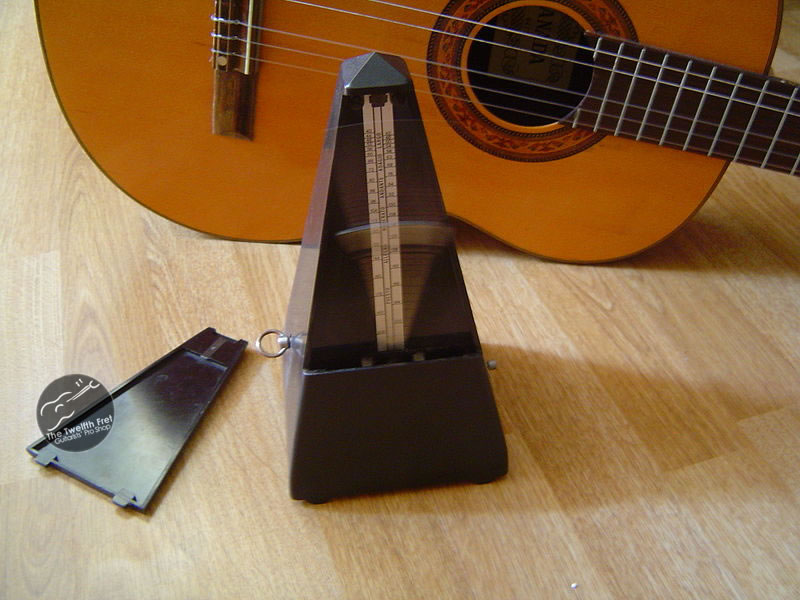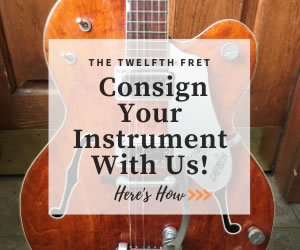
The Metronome
One of the less glamorous but critically helpful tools for any musician is the metronome. Ranging from simple clock-spring click devices to electronic boxes capable of multiple rhythms and time signatures, properly used the metronome can quickly improve your playing. It is essential if you are playing with other musicians or want to record your music.
Like tuning, our sense of time is partly learned and many things that will cause a player to speed up or slow down. We naturally tend to speed through things we’re familiar with, and slow down for things that are more challenging or uncertain. The metronome provides a steady reference, letting you know when you have changed tempo. Regular metronome practice helps you build the physical strength and stamina needed to play consistently and comfortably.
Metronome practice sounds dull, but it doesn’t have to be, and the results can be dramatic and helpful. All professional musicians practice with metronomes to keep their meter accurate and consistent.
For the first artist evening at The Twelfth Fret, we hosted guitarist Mike Francis, who has played on countless recordings, commercials, soundtracks and stages over the last few decades. He described part of his practice regimen with scales and a metronome. He devotes specific times to playing scales with a metronome, and works towards playing cleanly referring to the beat but sounding like fluid musical passages rather than rigid exercises. He also carries a small metronome with him as part of his session kit and during the evening used it several times to set out tempos with the bass player.
There is a type of meter called ‘Rubato’ where the tempo speeds up or slows down to add an expressive effect. While it is useful and effective, rubato starts from and returns to ‘straight’ time and is usually used by a single performer or with a conductor to keep the players together.
Types of Metronomes
Ages ago, mechanical wind-up metronomes were all you could get but now there are many inexpensive electronic versions, and metronome apps that run on smartphones, tablets and computers. Standalone electronic metronomes can be the size of a few credit cards and easily fit in a pocket, and for professional use there are table-top models like the Boss DB-90 Dr. Beat. There are also other options including drum machines and music tab software.
Basic Use
The simplest way to use a metronome is to set it to counting on the beat, set a tempo, and go. Play along with the click until you don’t hear it because you are perfectly in time. With practice, you will become more and more physically comfortable with staying in tempo and wander away from the beat less and less.
When you’re comfortable playing the passage at its listed speed, you can make it more challenging by slowing the tempo. We have a natural tendency to rush the familiar and slowing the metronome helps break that habit. Playing slower can also expose a surprising number of subtle technique issues you’ll want to work on.
Extra Credit
Most electronic metronomes let you choose alternate beats, like dotted quarter and eighth note pairs and this will help you learn ‘swing’ rhythms. Many have speed training settings that help you play faster and cleaner. Set a starting tempo and passage length – a set number of bars -and the metronome will increase its speed as it repeats the passage.
Some metronome apps can mute themselves for periods of time. This lets you check to see how you’re able to maintain your speed; you play with the metronome for a bit, it mutes, and when it comes back you should still be on the beat. If not, practice more!
Some higher end metronomes like the Boss DR-80 Dr. Beat can ‘speak’ the count, helping you learn to do this yourself and to keep track of where you are in a score. Learning to break down a count is a very important tool for making your way through printed music.
Drum Machines
Many practice amplifiers, like the Vox Mini 5 Rhythm, come with a drum machine built in. These do have some limits – you can’t adjust time signatures, and the patterns can’t be edited or chained together – but they make tempo practice a lot more ‘real’ and basic drills and basic practice can be much more enjoyable.
Tab Software
If you want to get really involved, guitar tab software can be used to help learn and work out more complex or challenging rhythms while staying on tempo. Using a single note, write out the rhythm you’re trying to learn. Set this to loop at a low tempo, then gradually increase the speed. Tab software ranges from free or inexpensive like TuxGuitar, and PowerTab to TablEdit and Guitar Pro at the top end.
~Patrick Keenan, The Twelfth Fret
